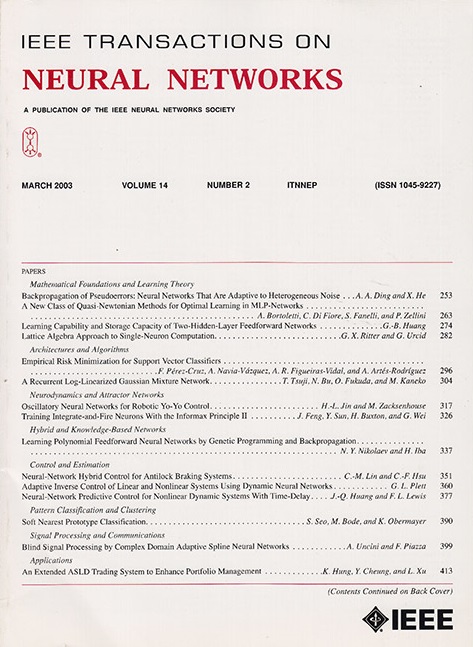Bicriteria Policy Optimization for High-Accuracy Reinforcement Learning.
IF 8.9
1区 计算机科学
Q1 COMPUTER SCIENCE, ARTIFICIAL INTELLIGENCE
IEEE transactions on neural networks and learning systems
Pub Date : 2025-09-09
DOI:10.1109/tnnls.2025.3605362
引用次数: 0
Abstract
In essence, reinforcement learning (RL) solves optimal control problem (OCP) by employing a neural network (NN) to fit the optimal policy from state to action. The accuracy of policy approximation is often very low in complex control tasks, leading to unsatisfactory control performance compared with online optimal controllers. A primary reason is that the landscape of value function is always not only rugged in most areas but also flat on the bottom, which damages the convergence to the minimum point. To address this issue, we develop a bicriteria policy optimization (BPO) algorithm, which leverages a few optimal demonstration trajectories to guide the policy search at the gradient level. Different from conventional problem definition, BPO seeks to solve a bicriteria OCP, which has two homomorphic objectives: one is from the standard reward signals and the other is to align the demonstration trajectories. We introduce two co-state variables, one for each objectives, and formulate two Hamiltonians for this bicriteria OCP. The resulting new optimality condition preserves the minimum values of both Hamiltonians. Furthermore, we find that gradient conflict is a key obstacle to simultaneously descending both Hamiltonians, and its impact is negatively proportional to the inner product between the ideal and actual gradients. A minimax optimization problem is built at each RL iteration to minimize conflicts between two homomorphic objectives, whose solution for policy updating is referred to as harmonic gradient. By converting its inner optimization loop into a linear programming with convex trust region constraint, we simplify this problem into a single-loop maximization problem with much increased computational efficiency. Experiment tests on both linear and nonlinear control tasks validate the effectiveness of our BPO algorithm on the accuracy improvement of policy network.高精度强化学习的双准则策略优化。
本质上,强化学习(RL)通过使用神经网络(NN)拟合从状态到动作的最优策略来解决最优控制问题(OCP)。在复杂的控制任务中,策略逼近的精度往往很低,导致与在线最优控制器相比,控制性能不理想。一个主要原因是,价值函数的景观不仅在大部分区域崎岖不平,而且在底部是平坦的,这破坏了收敛到最小点。为了解决这个问题,我们开发了一种双标准策略优化(BPO)算法,该算法利用一些最优演示轨迹来指导梯度级别的策略搜索。与传统的问题定义不同,BPO寻求解决一个双标准OCP,它有两个同态目标:一个是来自标准奖励信号,另一个是对齐演示轨迹。我们引入了两个共同状态变量,每个目标一个,并为这个双准则OCP制定了两个哈密顿量。得到的新最优性条件保留了两个哈密顿量的最小值。此外,我们发现梯度冲突是同时下降两个哈密顿量的关键障碍,其影响与理想和实际梯度之间的内积成反比。在每次强化学习迭代中建立一个最小化两个同态目标之间冲突的极大极小优化问题,其策略更新解称为调和梯度。通过将其内部优化循环转化为具有凸信任域约束的线性规划,将其简化为单环最大化问题,大大提高了计算效率。在线性和非线性控制任务上的实验验证了BPO算法在提高策略网络精度方面的有效性。
本文章由计算机程序翻译,如有差异,请以英文原文为准。
求助全文
约1分钟内获得全文
求助全文
来源期刊

IEEE transactions on neural networks and learning systems
COMPUTER SCIENCE, ARTIFICIAL INTELLIGENCE-COMPUTER SCIENCE, HARDWARE & ARCHITECTURE
CiteScore
23.80
自引率
9.60%
发文量
2102
审稿时长
3-8 weeks
期刊介绍:
The focus of IEEE Transactions on Neural Networks and Learning Systems is to present scholarly articles discussing the theory, design, and applications of neural networks as well as other learning systems. The journal primarily highlights technical and scientific research in this domain.
 求助内容:
求助内容: 应助结果提醒方式:
应助结果提醒方式:


